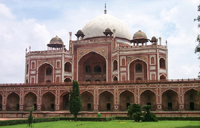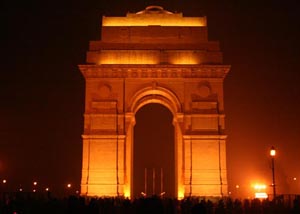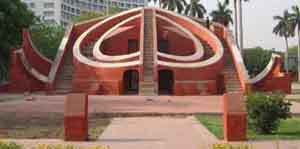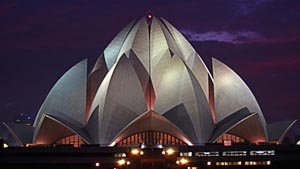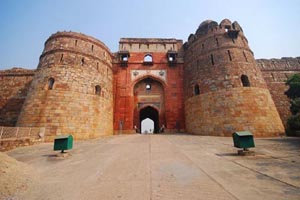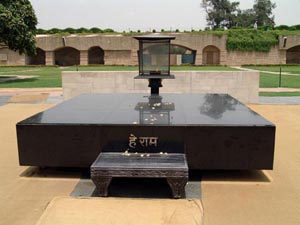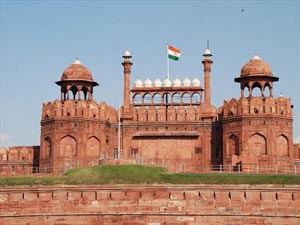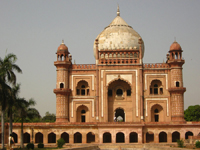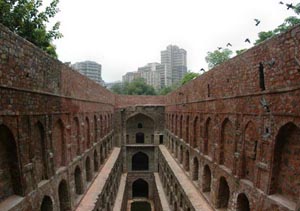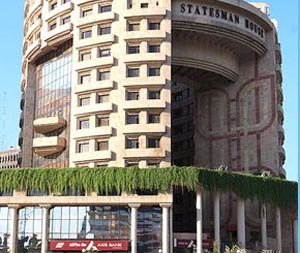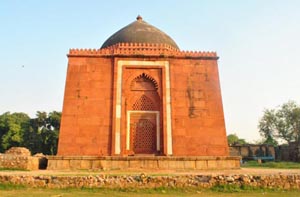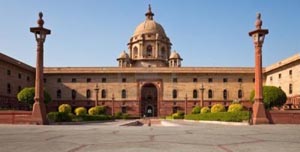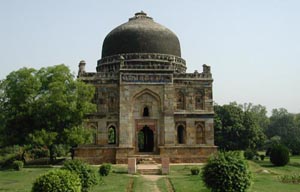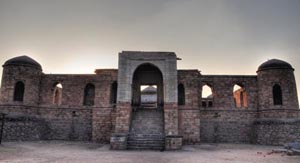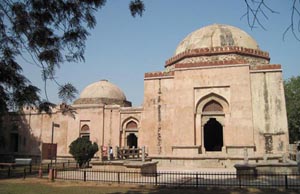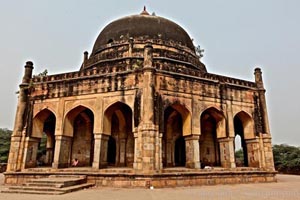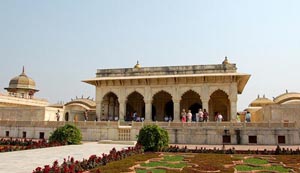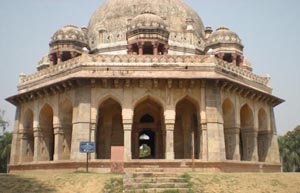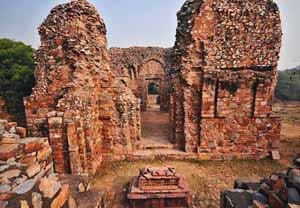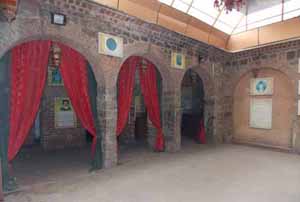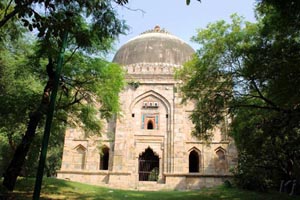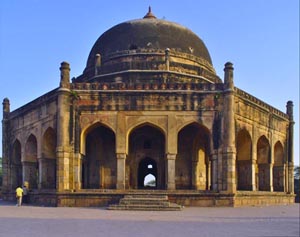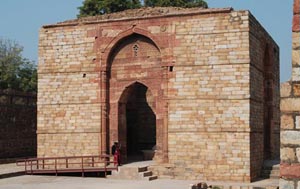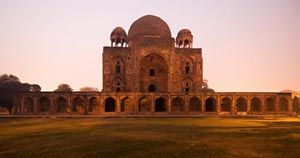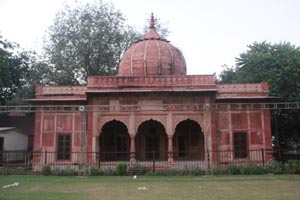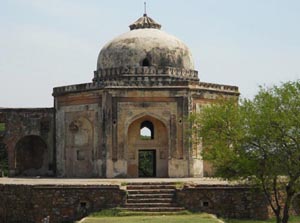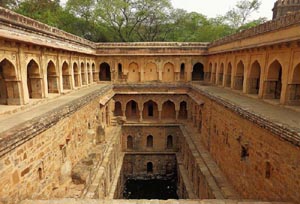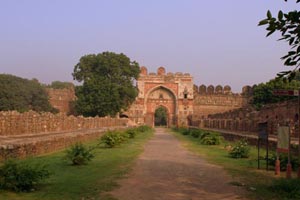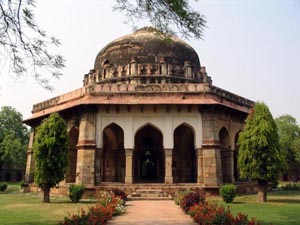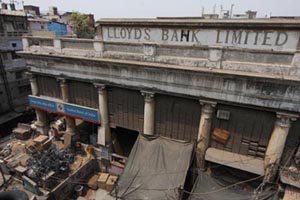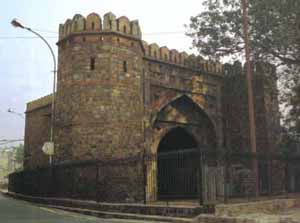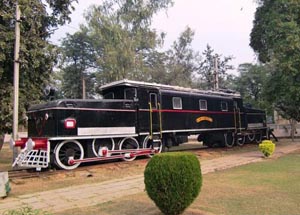New Delhi Monuments - Famous Historical Places, Forts & Palaces
List of names of Famous Historical Forts / Palaces / Places of New Delhi
Here you can find list of names and information on historical forts / palaces/ places / monuments in New Delhi, India. These famous monuments of New Delhi state are most visited and most sought after best tourist places. You can also find images of New Delhi monuments / places / forts / palaces.
The mausoleum of the renowned Mughal Emperor Humayun is popularly known as Humayun's Tomb. It is situated in the capital city, Delhi. It is located nearby Dina-panah fortress which also commonly acknowledged as Purana Qila in Nizamuddin East, Delhi. The Purana Qila was founded by Humayun in the year 1553. Apart from the area of the Humayun's tomb, the passageway leading to the main tomb includes various other smaller monuments starting from the key entrance area.
The India Gate was earlier christened as the All India War Memorial which honours 70,000 brave Indian soldiers who laid down their respective lives in the World War I while serving the British Army. The monument appears like a portico amid a cross road in the heart of New Delhi. It is stated to be a war cenotaph situated across the Rajpath, at the east end of New Delhi, previously known as Kingsway.
The distinguished monument Jantar Mantar is situated in New Delhi. It comprises 13 kinds of architectural mechanisms related to astronomy. It is deemed to be among the five different observatories that were constructed in the year 1724 by Sawai Jai Singh II who was the then Maharaja of Jaipur. These observatories were learnt to be built for the quest of scientific comprehension. The Maharaja served the Mughal court as a noble and was known to be quite an ardent astronomer.
The Lotus Temple is situated in the capital city New Delhi, India. It is also referred as the Bahai House of Worship or the Bahai Temple. The Lotus Temple is considered to be quite an imperative landmark in New Delhi. The unique characteristics of the temple make it one of the most highly visited edifices nationally as well as globally. The construction of the Bahai Temple was completed in the year 1986. The temple is precisely positioned in Kalkaji, New Delhi.
The old fort of Delhi is also known as the Purana Quila and is one of the oldest forts in Delhi. It is supposed to be the oldest form of known structure of its kind in Delhi. It was reconstructed on the similar spot by the popular Afghan king, Sher Shah Suri. The location of the old fort or the Purana Quila is supposed to be shared by the much respected and holy Indraprastha, which was supposed to be the capital city of the famous Pandavas.
Qutub Minar is quite a prominent historical monument which is located at the capital city of India, Delhi. The Qutub Minar is a stone tower which is also referred as a minaret and stands 73 metres tall in height. The height of the minaret is considered to be an unique characteristic and therefore, it is known to be one of the tallest minarets in India. The minaret was learnt to be actually constructed so as to mark the victory of a Muslim ruler, Qutub I-Din Aibak after claiming the last ever Hindu empire in Delhi.
Raj Ghat is situated in Old Delhi on the river banks of Yamuna. The Raj Ghat basically is a monument which was built in the honour of the father of our nation, Mahatma Gandhi. The Raj Ghat is a raised platform made of black marble which has been erected on the spot where the cremation of Mahatma Gandhi took place on 31st January in the year 1948, just a day following his assassination.
India has some of the beautiful and ancient monuments that date back to centuries old. The capital of India, the city of New Delhi has been under the reign of various kings and emperors over a long period of time. This means that there are many such beautiful amazingly enchanting monuments. One such is the Red Fort also called the 'Lal Qila' in India. This eminent fort was the place of shelter for the Mughal emperors for more than 200 years.
The Safdarjung's Tomb is a mausoleum which is made of marble and sandstone. The Safdarjung's Tomb was erected in the year 1753-1754 as the last resting place of Safdarjung who served as the viceroy or Subadar Nawab of Awadh during the emperorship of Mohammed Shah. The tomb includes numerous pavilions that are comparatively smaller in size with suggestive names such as Moti Mahal, Badshah Pasand and Jangli Mahal and stands as perfect instances related to Mughal artistry.
Agrasen ki Baoli, also recognized as Ugrasen ki Baoli or Sehingga Sain ki Baoli, has been chosen as a well looked after structure according to the Ancient Monuments and Archaeological Sites and Remains Act of 1958 by the ASI. The monument is basically an ancient step well which is 15-meter in width and 60-meter in length. It is located nearby to Connaught Place on Hailey Road, New Delhi. It is also close to another historical monument, the Jantar Mantar.
Barakhamba is also referred as the Barakhamba Monument which is building with a tomb and belongs to the Lodi period of 14th century. The monument is situated in New Delhi, India. The name of the monument stands for twelve pillars in both Hindi and Urdu languages. The name of the monument has even been shared for a recent posh metro road in the name of "Barakhamba road" located in Connaught Place which is considered to be the main part of the city.
Lal Gumbad or the Rakabwala is located in the city of Delhi in Malviya Nagar. The Lal Gumbad was constructed in the late 13 century by Shaikh Rauashan Ud Din Auliya. He was the adherent of Shaikh Rauashan Chirag. In the year of 1397 corporeal remains of Shaikh Kabir Ud Din Auliya was obscured. The construction of this Gumbad was over after it was completed entirely in the middle of 14th century.
Rashtrapati Bhavan actually means Presidential Residence and is considered to be the authorized residence of the Indian President and is situated in New Delhi. It is believed to be the sole manor of its kind which has 340 numbers of rooms in the central building which houses the, guest rooms, official residence, offices and halls.
The Shish Gumbad is situated amidst the luxuriant green and unreserved locales of the well-known Lodi Gardens in New Delhi. This is the crypt of the last tomb of the Sultan dynasty's period. This tomb is of Mohammed Shah. Through an architectural viewpoint of this crypt follows the prototype of the one which is fundamentally used in a large amount of the Lodi tombs with a double storied manifestation and is similar to the cottage of the Bara Gumbad mosque in its structure.
Sultan Ghari was the first Islamic burial chamber built in the year of 1231 AD. The tomb was built for Prince Nasiu'd-Din Mahmud, the eldest son Iltutmish. The tomb is built in the funerary of Delhi, Malakur village. Iltutmish was the third Sultan of the slave reign. He ruled in Delhi from 1210 -1236 AD. The Ghari tomb is to be found in the part of the foremost city of Medieval Delhi, which is known as the Slave Dynasty which feints during the period 1206-1290.
The tomb of Firoz Shah Tughlaq is situated in the Hauz Khas Village, Old Delhi. Firoz Shah belonged from the Tughlaq dynasty of Delhi. He was a sultan who took keen curiosity in the field of architecture. Firoz Shah Tughlaq reigned on Delhi from the time period of 1351 to 1388. It was learnt from various available historical records that he had constructed several religious institutions, different schools along with earthworks. The design of the tomb is known to be quite simple with a reflection of artistic taste.
Jahanpanah is known to be a medieval city or town of Delhi which was supposed to be the fourth city of its kind and was developed by the emperor, Muhammad bin Tughlaq during the time period of 1326 to 1327. Jahanpanah is Persian language means "Refuge of the World". The planned and protected city, Jahanpanah was established in order to deal with the continuous intimidations given by the Mongols.
The Khas Mahal was used as a personal abode of the Mughal emperors in Delhi. This monument is situated inside the premises of a huge compound within the city area, Red Fort. This structure was constructed by the great Mughal emperor, Shah Jahan between the period of 1631 to 1640. The Khas Mahal is also alternatively known as Aramgah-i-Muqaddar. A river runs on one side of the structure and on the other side lies another structure that is the Anguri Bagh.
The tomb of Mohammed Shah is located in a popular park, Lodi Gardens in Delhi. The Lodi Gardens is spread over an extensive area of more than 90 acres and includes quite some popular historical monuments within the complex such as Sikander Lodi's Tomb, Bara Gumbad, Sheesh Gumbad and Mohammed Shah's Tomb. These sites are maintained and looked after by the Archaeological Survey of India (ASI).
Balban's Tomb is situated in Mehrauli Archaeological Park of New Delhi. It was established in the year 1287 and thus possess significant historical significance. Balban's Tomb was the first true arch made establishment of India. It is a 13th century grave where the last sultan of Slave family, i.e. Balban was buried and therefore regarded as Sultan's ultimate resting place.
Mirza Ghalib Haveli is a heritage place situated near 'Gali Qasim Jaan' of old Delhi. It reflect the mighty Mughal time period. The large complex of the haveli, characterised by large decorated pillars and bricks are the rumination of the Mughal realm. The walls of the havelli are decorated with massive picture of Mirza Ghalib. His verses are also hung around the walls of the building. Furthermore, the pictures of other popular poets can also be observed in the haveli.
Bagh I Alam is located near to the Hauza Khas Lake and the Gumbad can be reached from the Deer Park, Delhi. It is one of the few Lodhi epoch tombs that have an amusing petition, with respect to the ambience. The structure of the Gumbad is prepared of confined stones, red sandstone and a mix of blue ceramic tiles. The stones and the tiles portrays it with a very dented petition, but the flourishing greens, the rambling natural gardens and the lawns surrounding it, with a multiplicity of birds flocking and deer wandering within a diminutive distance away gives a divine getaway.
The tomb of Adam Khan is referred to as Bhool Bhulaiya and is located just at the back of the famous structure, Qutub Minar which faces the bus stand in Mehrauli, Delhi. Bhool Bhulaiya actually means labyrinth or maze. Adam Khan served as a general in the Mughal army during the reign of Akabar, the eminent Mughal Emperor. The place or rather the structure is given imperative significance as it is believed that once an entire lot of wedding attendees taking shelter in the Bhool Bhulaiya went missing inside it.
Iltutmish Tomb is a memorial tomb established by Shamshuddin Iltutmish in the year 1235. It is situated in the northwest side of Quwwatu'l Islam Mosque of New Delhi. Iltutmish Tomb has glorious history and simple yet sophisticated architecture. It is the first structure of India which used 'squinch arches'. Primarily revelling in honour, Iltutmish Tomb provides the rightest picture of the traditional times of India.
The Khan-i-Khanan's tomb is also known as the tomb of Abdul Rahim Khan-i-Khanan. It is located on the Mathura road in the area of Nizamuddin,Old Delhi. The mausoleum is situated at a walking distance from the Humayun's tomb. The complex that houses the tomb is quite large and the mausoleum is known to look discarded along with being dilapidated. An initial look is supposed to be enough to decipher the fact that the mausoleum has been ripped of its adornment in time.
Lal Bangla is a complex which consists of two distinct burial places or rather tombs which are believed to hold the earthly remains of Lal Kunwar and Begum Jan. Lal Kunwar was the mother of the 18th Mughal Emperor, Shah Alam II and Begum Jan was his daughter. Each of the structures or the tombs includes two square shaped rooms that are positioned crosswise with rectangular walls running between them. The monument is presently managed by the Archaeological Survey of India (ASI).
Dilkhusha which is also known as the tomb of Quli khan, brother of Adam Khan, a general and look after brother of Sovereign Akbar. The octagonal Mughal crypt was built in the 17th century which was bought by Metcalfe and reconstructed in the technique of European residences with widespread gardens and follies for use as a gratification resort throughout the monsoon season. He named it the Dilkhusha. It was widening over a rambling area, which is now together with, in a specifically residential park called the 'Qutub Archeological Village'.
The Rajon Ki Bain is also alternatively known as Rajon Ki Baoli and is a popular step-well situated close to Adham Khan's Tomb in Mehrauli, Delhi. Delhi, regardless of its situation beside the famous river Yamuna, has at all times witnessed difficulties with respect to water supply. The issue of acute shortage of water arises partly due to the tremendously hot and long duration of summer and also for the nearness of the parched zones of adjoining Rajasthan and Harayana.
Sher Shah Suri gate is a splendid gate developed by Mughal ruler. It is situated in Mathura road of Delhi, at the opposite side of outstanding leftovers of Purana Qila. The gate is named according to its founder's name, i.e. Sher Shah Suri, who was the king of Mughal kingdom. He took authority over the Mughal kingdom in the year 1540. He created this gate after conquering the supreme force of king Humayun. Sher Shah Suri gate is supposed to highlight the southern verge of the empire of Sher Shah Suri.
Lodi Garden is known to be scattered with structures during the Lodhi and Sayyid Periods and consists of mosques, tombs and bridges. The Lodhi Gardens is an eminent park situated in Delhi and involves an area of more than 90 acres. It is known to house prominent architectural works prevalent during the 15th century by an Afghan dynasty, the Lodhis which includes Sikander Lodi's Tomb, Mohammed Shah's Tomb, Bara Gumbad and the Sheesh Gumbad.
Begum's Palace which is commonly known as 'Bhagirath Palace' is a popular monument which was actually a fortress of a princess named Begum Samru. The palace is situated in Chandni Chawk of Old Delhi and is regarded as a grandeur through British realm. Among various other palaces of Begum Samru, the one which is situated in Chandni Chawk is celebrated to be the most magnificent. Begum's Palace lived its era of splendour during the British dominion and it is a wonderful historical monument of Delhi.
Traditionally, Delhi was regarded as the city of 'seven castles' characterised by 52 gates. However, at present only 13 gates remains and can be recognised by travellers. One of the 13 gates is Delhi gate. It is a one of the gateways of Shahjahanabad, the seventh city of Delhi. The city was created during 17th century and was established like huge fort enclosed by robust walls with 14 gates.
The National Rail Museum is located in Chanakyapuri, New Delhi and aims at throwing light on the heritage value of Indian rail. It opened its doors to the public on 1st February in the year 1977. The museum claims an area of more than 10 acres which includes both outdoor as well as indoor displays. A ride on the toy train is made available around the area of the museum on usual days.
- Andaman Nicobar Monuments
- Andhra Pradesh Monuments
- Assam Monuments
- Bihar Monuments
- Chhattisgarh Monuments
- New Delhi Monuments
- Goa Monuments
- Gujarat Monuments
- Haryana Monuments
- Himachal Pradesh Monuments
- Jammu and Kashmir Monuments
- Karnataka Monuments
- Kerala Monuments
- Madhya Pradesh Monuments
- Maharashtra Monuments
- Odisha Monuments
- Punjab Monuments
- Rajasthan Monuments
- Tamil Nadu Monuments
- Telangana Monuments
- Uttar Pradesh Monuments
- West Bengal Monuments
